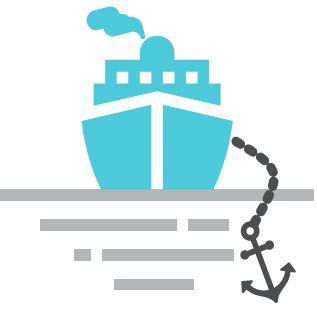Use the search below to find question.
Amount of questions: 78 .
Right answers marked with this sign
A Ship to Shore Safety Checklist can be found in which publication?
ISGOTT .
ISPS code.
SOPEP .
A cargo tank wash plate improves intact stability.
A combination carrier loaded with crude oil has two tanks, each only 60 % full. What affect will this have on the vessel’s stability?
GM .
A vessel is to maintain light ballast condition, however if logged and permissible bending moments have been exceeded, you would …
A warning may be posted in the cargo control room (CCR ) when some ballast or cargo tanks are slack due to …
As part of the Safety Management System (SMS ), new personnel joining the tanker must be …
hours to recover after travel.
At commencement of loading, the generation of static is controlled by …
Before loading, you should ensure that …
Cargo tank temperature and pressure gauges and reliquefaction plant instruments should be calibrated …
Cargo transfer operational information will normally be available in …
SOLAS training manual located in the officers’ and crew lounge.
CCR ).
Damage due to sloshing is a direct result of the tank …
Different grades on a product tanker are normally segregated by …
During cargo operations, VHF/UHF radios power output is …
GMDSS logbook.
During cargo transfer, what action would you take if the Inert Gas System fails?
Emergency shutdown valves in liquid piping should fully close under all service conditions within …
seconds .
seconds .
seconds .
seconds .
Flammability and toxicity of proposed cargo can be obtained from …
MSDS ).
ISGOTT .
SOPEP file.
How do you ensure that pre-cargo transfer stability and stress calculations are correct?
How does «free surface effect » (sloshing) affect the ship’s stability?
How does the Chief Officer ensure the approved stress and stability computer is giving accurate results?
How long must logbooks and other cargo records be kept on board?
months after discharge.
If hydrocarbon gases are found in double hull ballast tanks, what action should be taken?
ISGOTT .
If the shore fails to deliver cargo at the requested rate, what action would the Master take?
P&I Club.
If unable to ground GMDSS equipment during cargo operations, what action may be taken?
In the loading limit formula, at which temperature is the pR value expressed?
degrees Centigrade.
In which documentation would you expect to find duties and responsibilities relating to the cargo system?
SMS ).
SOLAS training manual.
In which language would you expect the operational and technical manuals to be written?
Night orders must be signed by the appropriate personnel …
Offshore manifold gauges need not be fitted?
On a combination carrier, where would the audible bilge alarm sound from a void space forward of the collision bulkhead?
CCR (cargo control room).
On what occasions will a pre-cargo transfer meeting be minuted?
Permissible bending moments are greater in which condition?
Prior to cargo transfer, where would you expect to see a reference to valves and gauges?
SMS ).
Sequential and flow through methods form part of …
Shore cargo hard arms are commonly known as …
The Ship/Shore Safety Check List states that temporarily removed scupper plugs must be …
The Ship Inspection Report Programme (SIRE ) states that the loading programme must be checked by means of an approved test programme at least …
The Vessels Inspection Questionnaire (VIQ ) states the maximum interval between the calibration of temperature and pressure gauges to be …
months .
months .
months .
The approved loading computer programme is malfunctioning, you would …
The location of technical manuals relating to the cargo system …
The port/cargo operations log will form the basis of …
SOLAS .
ISPS implementation.
The principle purpose of a pre-cargo transfer meeting is to …
Under normal operations, a cargo tank should not be filled higher than …
SOLAS regulation.
Vessels with large width tanks are more susceptible to …
What alternative is available when an approved test programme is not available to check the loading computer?
What competent body would normally approve a loading instrument/programme?
SOLAS .
P&I Club.
What does code «R » indicate in the Ship/Shore Safety Check List?
What is a schematic drawing?
What is meant by the operating envelope when referring to loading arms?
What is the name of the diagram that is superimposed on the cargo control console?
What material should manifold reducers be made of?
GRP (glass reinforced plastic).
What medium is used to purge cargo tanks that have previously carried crude oil?
What must be monitored before entering the pumproom during cargo operations?
What precaution must be taken when removing a blank flange?
When calculating the UKC , what is the «controlling depth »?
When can cellular mobile phones be used to assist with cargo transfer communications?
GMDSS equipment is switched off.
VHF/UHF’s are not available.
When discharging segregated ballast, the overboard discharge must be monitored …
When must the Chief Officer’s standing orders be followed?
When should P/V valves be checked for free movement?
ISM code.
ISPS code.
When starting a centrifugal cargo pump, the discharge valve should be initially …
When would you exceed the maximum pressure ratings of the cargo system?
When would you need to check the intact stability at intermediate stages of cargo transfer?
When would you use the Chief Officer’s personally developed loading / stress monitoring computer programme?
Whenever an AIS (Automatic Identification System) has to be kept on during cargo operations, what precautions must be taken?
AIS a dummy load.
SOLAS .
Where are temperature and pressure gauges normally calibrated?
Where on the cargo manifold are pressure gauges fitted?
Where would a plan indicating the location of cargo measurement instruments, sensors, pressure gauges, etc normally be found?
CCR (cargo control room).
Where would you expect to locate a mimic diagram of the cargo system?
CCR ) operational panel.
Where would you find approved information regarding the vessel structural strength?
OCIMF Ship Inspection Report Programme.
Where would you find information relating to intact stability and stress limitations?
MARPOL publications.
SOPEP Manual.
Where would you normally expect to find a full set of cargo operation instructions?
CCR ).
SOLAS training manual in the crew’s lounge.
Who has overall responsibility for the maintenance of the cargo system?
SMS ).
Why are main radio transmitter aerials grounded during cargo operations?
Why is it important that the Plan Maintenance System (PMS ) have specific instructions relating to valves and cocks for the pressure gauges?
ISM code.
Why is it important to keep the cargo manifold area clear of obstructions?
Why is it important to pre-plan all aspects of cargo operations?
ISM code.
Why is it important to regularly check offshore manifold gauges during a cargo transfer?
MSDS (Material Safety Data Sheet).
Why must a cargo tank atmosphere be monitored during crude oil washing?
Why should you monitor void spaces, cofferdams and empty ballast tanks during a loaded passage?

